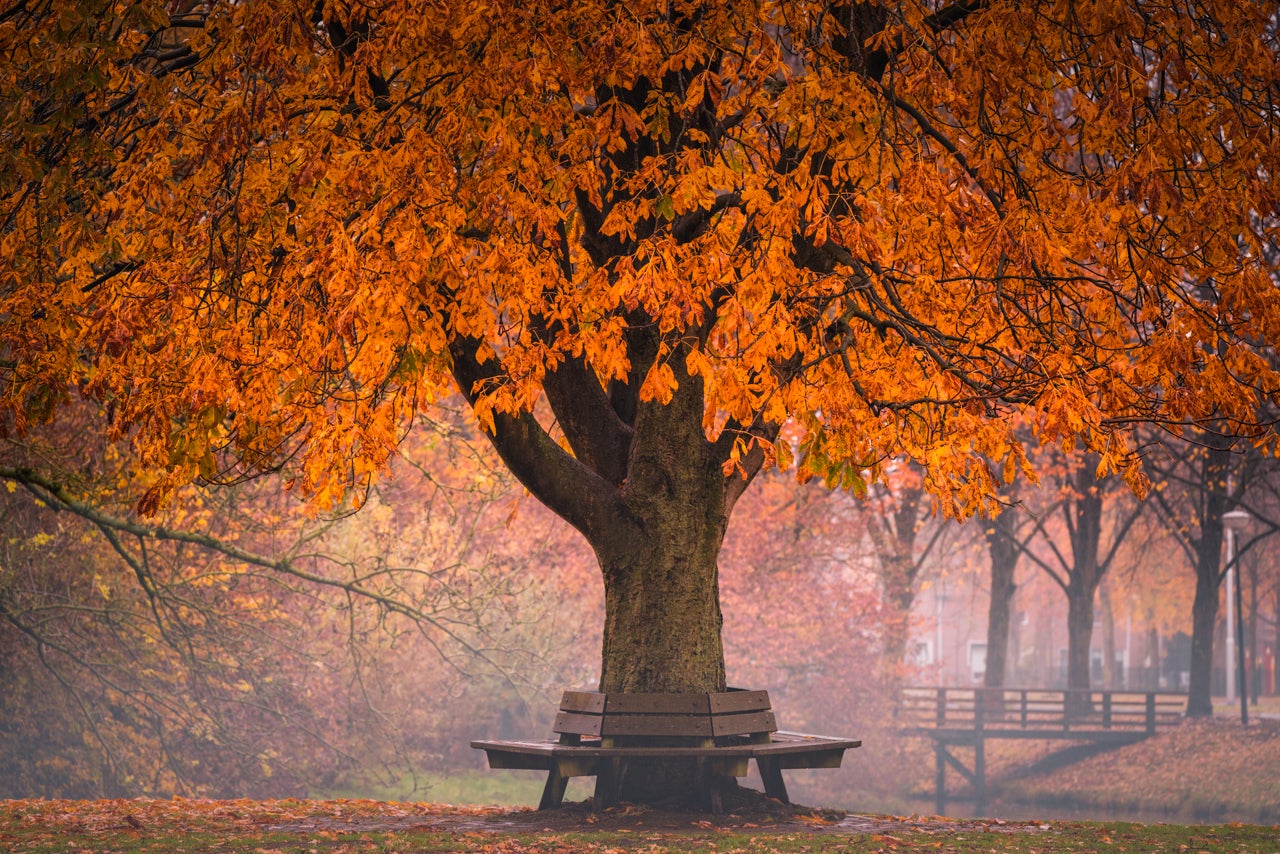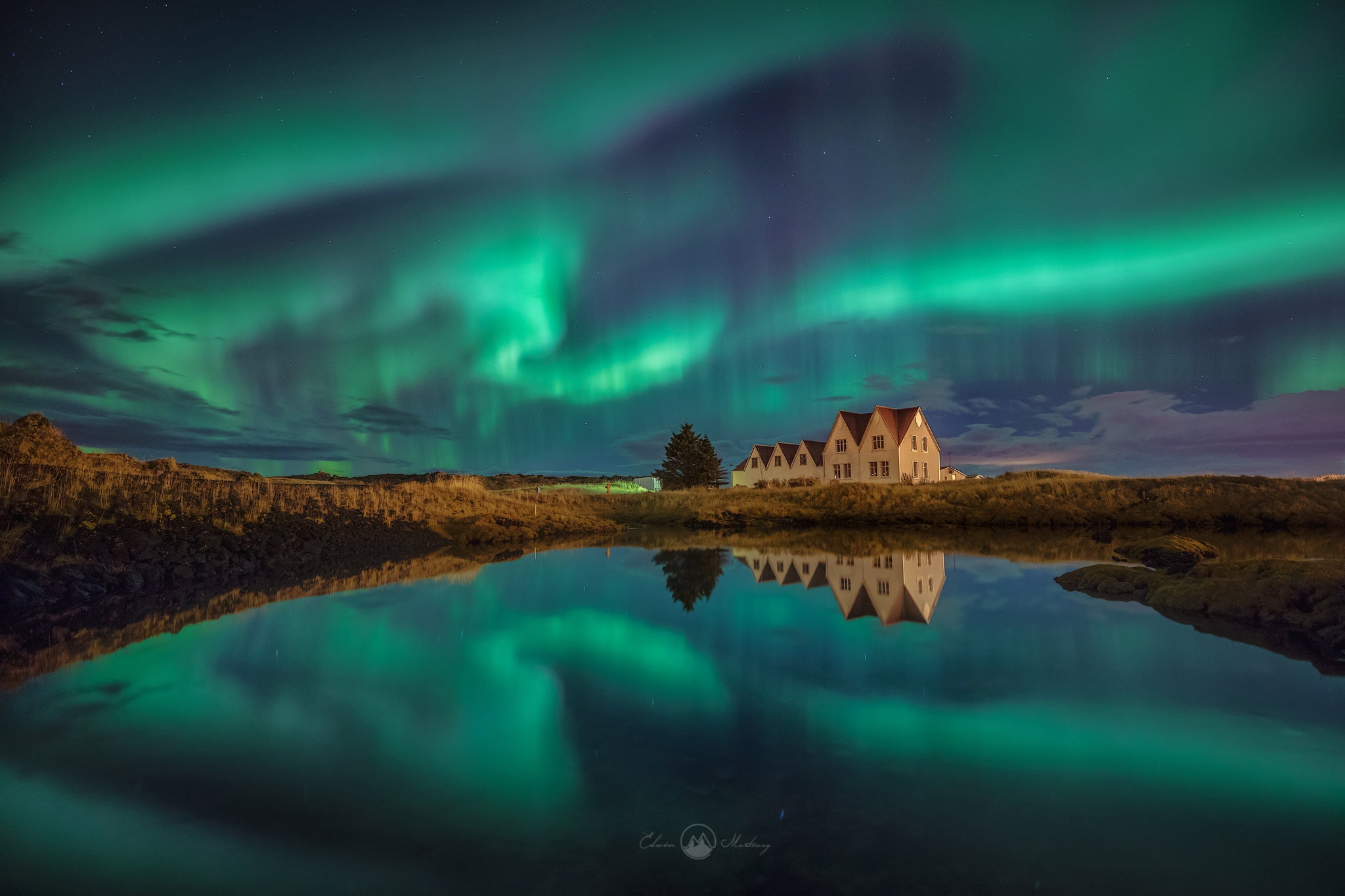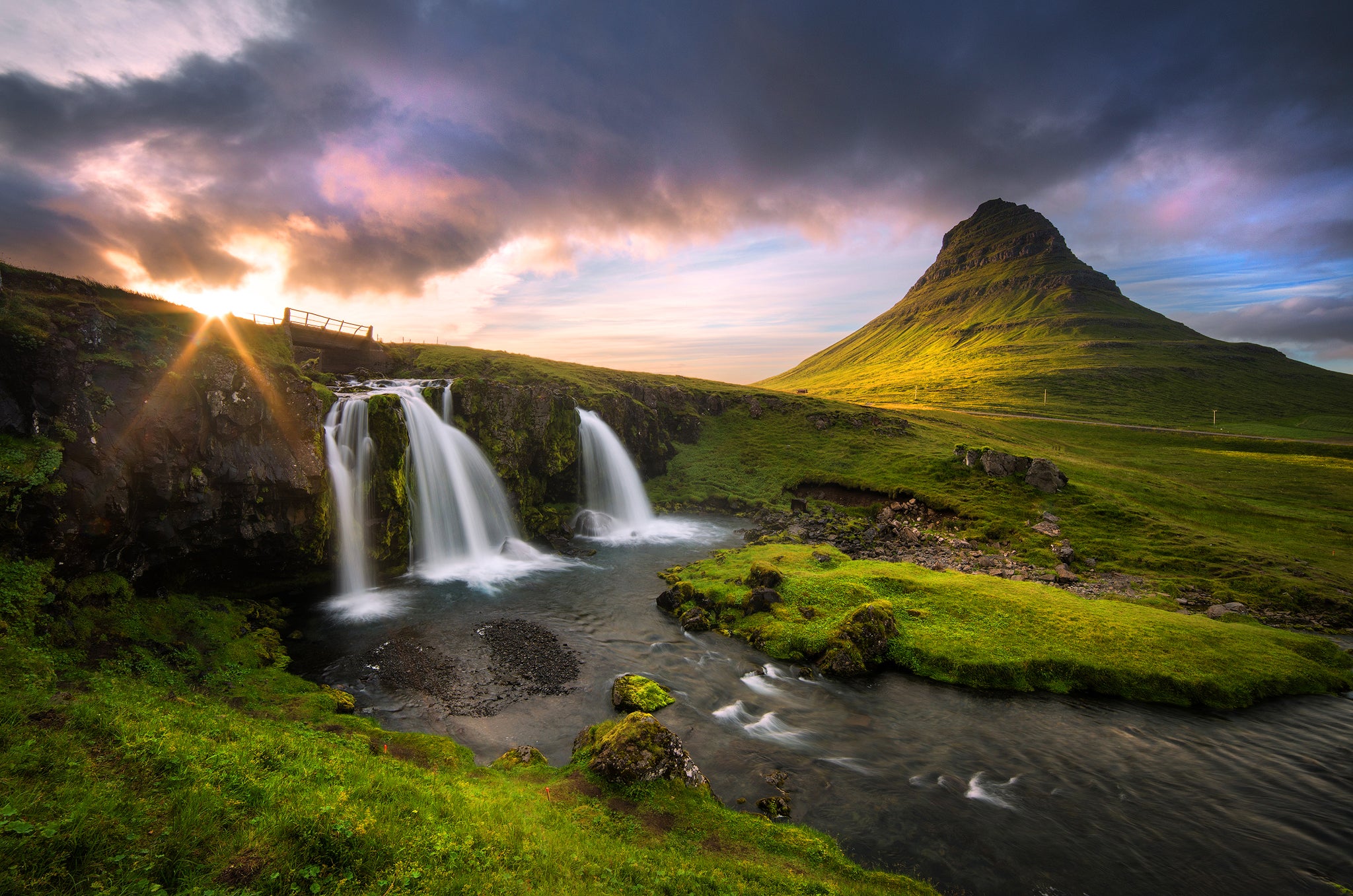Ah rainbows… whether you understand them scientifically or choose to believe that they’re magic, these beautiful meteorological phenomena are sure to make you feel happy whenever they appear in the sky over Iceland.
- Join us on this 11 Day Iceland in Autumn Photography Workshop
If you’re lucky enough to see one, then you’ll probably want to capture a real picture of the rainbow on your camera. After all, who wouldn’t want to photograph such an amazing wonder of nature within the vast and expansive landscape of Iceland? For photographers who happen to be at the right place at the right time, a rainbow can make an otherwise ordinary or well-photographed scene in Iceland appear absolutely unique and extraordinary.
Despite being one of the most beautiful ways of spicing up a picture, photographing a rainbow can also be frustrating, particularly if you’re not entirely sure how to capture it or if you aren’t equipped for the moment. To make sure you’re prepared when you visit Iceland, let’s take a look at how rainbows are formed, the different types of rainbows that you are likely to see in Iceland, as well as the gear that you’ll need for the job. We'll also explore some of the ways that you can incorporate a rainbow into your landscape photography of Iceland and give you a few post-processing tips that will help you to improve your rainbow photos.
What is a Rainbow?
Put quite simply, a rainbow is a weather phenomenon that is caused by the reflection, refraction and dispersion of light within water droplets in the Earth’s atmosphere.
When the sunlight passes through the droplets, the light is bent and reflected as a multicoloured spectrum of light that appears in the sky.
Although rainbows appear as full circles, they are usually only seen as a circular arc.
There are many types of rainbows that occur naturally within the Earth’s atmosphere, classified by the processes in which they are formed. The following is a brief rundown of a few of the types of rainbows that you might see during your photography tour in Iceland.
Primary Rainbows

This is the type of rainbow that you’re probably most familiar with. It is a single, multi-coloured arc that usually appears after the rain. Primary rainbows are formed when refracted light is reflected through a water droplet, and the intensity of the rainbow’s colours depends upon how large the water droplets are.
You’ll be able to spot primary rainbows in Iceland any time that the sun peeks out from behind the clouds after a burst of rain.
If there hasn’t been any rain, then the secret to spotting a primary rainbow in Iceland is to head towards a waterfall! This is because the same kind of process that produces rainbows in the sky is responsible for producing rainbows within the spray of a thundering cascade of water, such as Skógafoss or Seljalandsfoss waterfalls on the south coast of Iceland.
However, to be able to see a rainbow within the spray of the waterfall, you’ll need to make sure that the sun is behind you.
Double Rainbows / Secondary Rainbows
Double rainbows are formed when the sunlight that is reflected within a raindrop occurs twice – once within the violet light that reaches your eye from the higher droplets, and a second time within the red light from the lower droplets.
This means that the secondary rainbow will appear about 10 degrees above the primary rainbow, with an inverted sequence of colours.
Full-Circle Rainbow

Usually, when we see a rainbow, we tend to only see it in a half. The other half almost always appears to be obscured by the horizon. However, in some rare circumstances in Iceland, you might be lucky enough to spot a full-circle rainbow!
The trick to seeing a full-circle rainbow in Iceland is to get up high above the landscape. When you are elevated above the water droplets in the sky, it will be possible for you to see the complete circle of the rainbow appearing before you.
If you are on the ground, then it will be very unlikely that you’ll be able to see the entire circle of a rainbow, unless you are looking into a canyon. For your best chances at photographing a full-circle rainbow in Iceland, you’ll need to either stand at the top of a very tall mountain, look out of an aircraft or try your hand at aerial photography.
Fogbows
A fogbow is a special type of rainbow that forms when sunlight travels through a small cloud or fog, resulting in diffraction between the fog droplets and the sunlight. The colour spectrum that you will usually see in a fogbow is white, red and blue.
In Iceland, fogbows tend to form over a body of water, such as at Lake Mývatn during winter, or in an area with thin fog.
Moonbows
 Moonbow with the Northern Lights at Gullfoss. Photo by: 'Iurie Belegurschi'.
Moonbow with the Northern Lights at Gullfoss. Photo by: 'Iurie Belegurschi'.
Moonbows are a type of rainbow that occurs when the moon’s light reflects and refracts off water droplets in the air, as opposed to being created by the sunlight itself. They require certain weather and astronomical conditions to be just right, meaning that they are a particularly rare type of natural atmospheric phenomena.
For a moonbow to be created, the moon has to be very low in the sky – no more than 42 degrees from the horizon. The moon phase also has to be full or nearly full.
To observe a moonbow, the sky must be very dark and water droplets must be present in the air in the opposite direction of the moon.
The Perfect Weather Conditions to Photograph Rainbows in Iceland
The best time to see a rainbow in Iceland is on a rainy day, after the rain clears and the sun breaks out from behind the clouds. You’ll need to position yourself such that the sun is behind you at a 42 degree angle relative to where you are standing, and make sure that the part of the sky where the sun sits is clear from clouds and other obstructions.
In addition, the area of the sky in which the rainbow will appear must still have rain or moisture in the form of water droplets. This means that when there is potential for a cloudy day with rain and intermittent sunshine, you should be heading out in Iceland to hunt for rainbows!
Keep in mind though that the centre of a rainbow is directly opposite to the position of the sun in the sky. Therefore, the higher the sun is, the lower the rainbow will be. You’ll be able to see a greater percentage of the rainbow as the sun approaches the horizon, either near sunrise or sunset.
If you happen to stumble upon a very faint rainbow, the best thing to do is to wait for it to get a little bit brighter. Oftentimes, rainbows can get very intense within a matter of minutes. So even if you only see a partial rainbow, wait around and you’ll be able to see the arc getting stronger before your very eyes.
Which Lens to Use and the Ideal Aperture for Rainbow Photography
To capture the beauty of a rainbow in its entirety as it spans across the glorious landscape in Iceland, you’ll need a wide-angle lens such as a 16-35mm on a full-frame camera.
Don’t bother whipping out a telephoto lens, as you won’t be able to fit the whole rainbow into the frame.
If your wide-angle lens still isn’t enough to capture the entire rainbow in one shot, then you might need to take a couple of photos and stitch them together as a panorama later on in post-processing.
Of course, you’ll want to make sure that all of your foreground and background elements within the landscape appear sharp within your photo. As such, you can refer to our article on the best aperture to use for landscape photography, or set your aperture to somewhere between f/8 and f/11.
Filters for Rainbow Photography
Attaching a polarising filter to your lens can really help to enhance the colours of the rainbow, as well as other foreground and background elements within the frame.
However, you should be careful when using a polarising filter, as dialling it incorrectly can mean that the rainbow will completely disappear as a result of the filter blocking the reflections of light.
So if you do decide to use a polarising filter, be sure to rotate it until the rainbow appears more vivid within the viewfinder or the LCD screen of your camera.
Should I Use a Tripod to Photograph Rainbows?
It's absolutely possible to photograph rainbows handheld, though to really capture the brilliance of a rainbow – particularly a moonbow or a fogbow – consider mounting your camera onto a tripod. This will help you to minimise camera shake, ensuring sharp and well-focused images. This is especially important when capturing a moonbow at night.
Compositions for Rainbow Photography
Similar to photographing the Northern Lights in Iceland, capturing a rainbow is not all about the rainbow itself. You’ll still need a strong and interesting composition to make your photo stand out. So consider using subjects such as waterfalls, rocks in the foreground or the peaks of mountains as your rainbow photography backdrop in order to enhance your composition.
Getting down low with your wide-angle lens in Iceland can also reveal a multitude of opportunities for amazing foregrounds, such as wildflowers in summer or cracks in the ice during winter which can act as leading lines. Never underestimate the power of foreground in landscape photography and if you’re really stuck, refer to our top 5 tips for composition when photographing the landscape in Iceland!
Best Places to Photograph Rainbows in Iceland
As we mentioned earlier, waterfalls are great places to photograph rainbows in Iceland. Try heading out to Skógafoss or Seljalandsfoss waterfalls on the south coast. More often than not, you'll be able to spot a rainbow drifting forth from the mist of these waterfalls on a sunny day.
You can also capture rainbows at Gullfoss on the Golden Circle. The best thing about this location is that it makes a wonderful composition for shooting moonbows when the conditions are just right.
 Double rainbow at Godafoss waterfall. Photo by: 'Iurie Belegurschi'.
Double rainbow at Godafoss waterfall. Photo by: 'Iurie Belegurschi'.
Goðafoss is another waterfall in north Iceland that is good for rainbow photography. You may even catch a rare double rainbow there beneath the Midnight Sun!
 Rainbow in the Highlands. Photo by: 'Alban Henderyckx'.
Rainbow in the Highlands. Photo by: 'Alban Henderyckx'.
For those who are a little more adventurous, try hiking out into the Icelandic Highlands. The colourful rhyolite mountain ranges of Landmannalaugar make a spectacular foreground for photographing rainbows on a stormy day.
Post Processing Tips for Rainbow Photography
Once you get home with your rainbow photos from Iceland, it's a good idea to do some basic editing to really make the rainbow pop.
Tip #1. Increase Saturation
Depending on the intensity of the colours in your photograph, you may benefit from increasing the saturation of your rainbow. This will really help to bring it out from the landscape, making it a feature rather than something that is lost in the sky.
Rather than increasing the saturation of the entire picture as a whole, try applying a local adjustment instead. This way, you'll only be enhancing the rainbow and not the rest of the scene.
Tip #2. Enhance Details
You can make rainbows look even more crisp and beautiful by enhancing the details. It's easy to do with Adobe Lightroom and can really help to make the rainbow stand out.
Again, rather than enhancing the details throughout the scene, apply a local adjustment so that only the rainbow is affected.
Tip #3. Darken the Sky
When you darken the sky, it helps to bring out the colours of the rainbow and can act to dramatically intensify its presence in the composition. All you need to do is to apply a gradient in the sky using a Graduated Filter tool in your post-processing software.
Drag the gradient so that the top part of the sky above the rainbow is darkened, while the rainbow remains unaffected.
Now that you know the background behind how rainbows form, as well as where to find rainbows in Iceland and how to shoot them, it's time to get out and about to practice your newfound knowledge!
Rainbows can really enhance your photographs by providing another element of interest that will draw the viewer in and keep their attention. By capturing this wonderful atmospheric phenomenon with the photography techniques that we've mentioned above, you'll be well on your way to taking amazing pictures of rainbows in no time. And who knows? You may even find a little pot of gold at the end.
About the author: Serena Dzenis is a landscape photographer based in Iceland. You can find more of her work on her website or by following her on Facebook and Instagram.
Let's go hunting for rainbows on a 12-Day Midnight Sun Photography Workshop Around Iceland!













